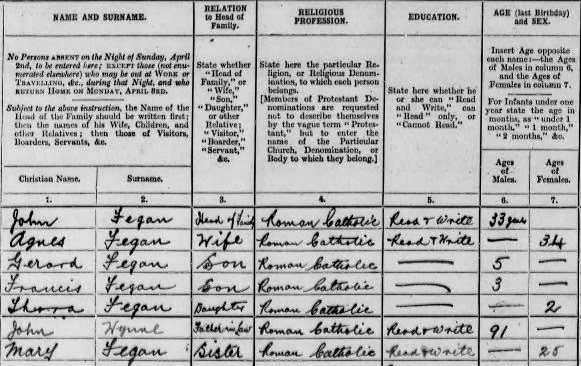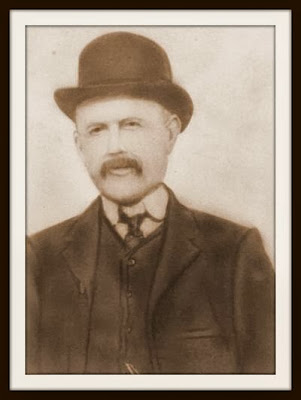John Wynne was my great-great grandfather. He was Patrick Wynne’s father. His place and date of birth remains a mystery today. The first identified record of him places him in Thomas St., Dublin around 1848. Both the 1901 and 1911 Censuses of Ireland state that his birthplace was Dublin city.
 |
John Wynne, 1911, excerpt from copy death register
|
A few days later, Agnes’s husband, John Fegan, organised his burial at Glasnevin Cemetery and again stated that John Wynne was sixty-seven when he died.
 |
John Wynne, 1911, excerpt from burial register (Glasnevin Trust)
|
This indicates he was born about 1843-44.
However, in April 1911, John Fegan filled out the household return of the 1901 Census and reported that his father-in-law was ninety-one years old. This suggests that his birth was about 1819-20. Why did Agnes and John Fegan then knock twenty-four years off this age, when he died only five months later? Were they aware of the inconsistency? Did they discuss it and agree that he was not as old as reported in the census?
 |
Fegan household, 24 Haliday Square, Arran Quay, Dublin (1911 Census)
|
A cynical person might suggest that John over-stated his age in the 1911 census, in an attempt to claim the old age pension before his due time. The pension was first introduced in Ireland in January 1909 and a general unexplained ‘ageing’ of the population between 1901 and 1911 has sometimes been attributed to its introduction. Civil registration of births did not commence in Ireland until 1864 and the authorities acquired a reputation for relying on census records, i.e. 1841 and 1851 records, as proof of age for pension entitlement.
Yet, John’s age recorded in the 1901 census confirms the estimate birth year as 1820-21 and the 1901 census was completed long before the pension was ever contemplated in Ireland. John Wynne filled in and signed the 1901 census himself and he said he was eighty years old, at the time.
 |
Wynne household, 11 Upper Ormond Quay, North City, Dublin (1901 Census)
|
So when was he really born?
www.irishgenealogy.ie, which freely provides transcriptions and images of many Dublin church records, includes the register of John's marriage to Bridget Hynes. They married in St Catherine’s, Thomas St., Dublin on 16 September 1849. Their first child, Margaret, was baptised in St Catherine’s on 2 July 1850. John could not have been only six years old at the time!
John was surely born at least ten years earlier than 1843-44 and probably closer to twenty years earlier. John’s own estimate of being born about 1820 seems much more reasonable than the estimate of 1844.
Was John Wynne a nonagenarian when he died? Why did his daughter get it so wrong when she registered his death?
Sources available on request.
.............
© 2013 Black Raven Genealogy









